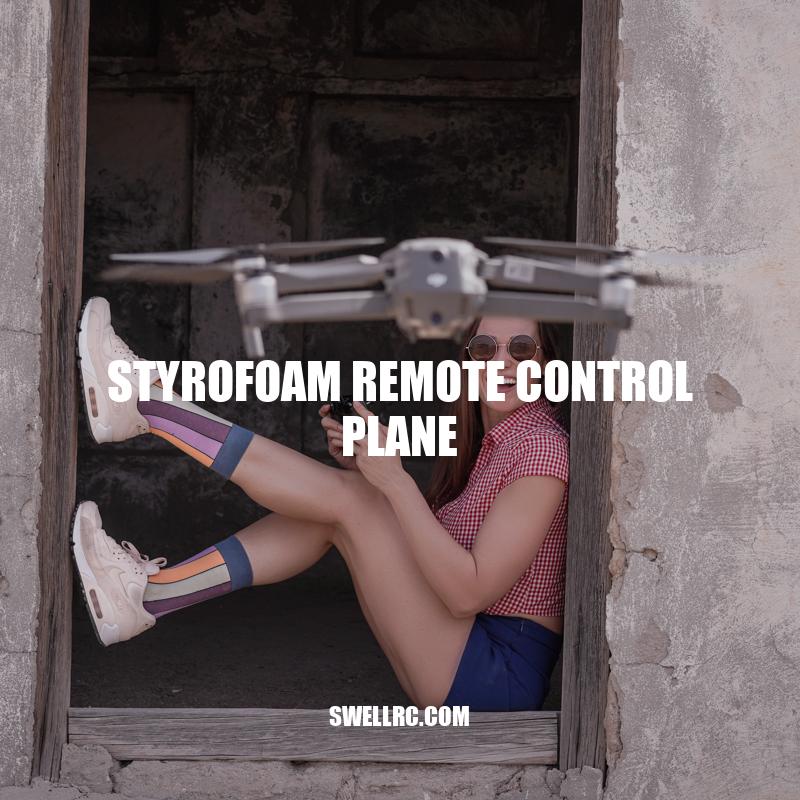Mastering the Styrofoam Remote Control Plane: A Guide to Building, Flying and Maintaining
Remote control planes have long been a beloved pastime for both enthusiasts and casual hobbyists. But the rise in popularity of the Styrofoam remote control plane has opened up a new realm of possibilities for those looking to take their flying to the next level. The unique properties of Styrofoam, including its lightweight yet durable nature, make it a popular choice among remote control plane builders and flyers alike. Whether you are a seasoned hobbyist or a newcomer to the world of remote control planes, the Styrofoam option offers a fresh take on this classic activity. In this article, we will dive into the fascinating world of Styrofoam remote control planes and explore how to build, fly, and maintain these innovative flying machines.
Advantages of Using Styrofoam for Remote Control Planes
Styrofoam is a popular choice for remote control plane builders and flyers for a variety of reasons. Here are some of the key advantages of using Styrofoam for remote control planes:
- Lightweight: One of the primary advantages of Styrofoam is its lightweight nature. This makes it easy to carry and transport your remote control plane wherever you go.
- Durable: Despite its lightweight nature, Styrofoam is also incredibly durable. It can withstand crashes and other mishaps that might cause other types of remote control planes to break or become damaged.
- Easy to Shape: Styrofoam is easy to shape, which makes it a great option for customizing your remote control plane. You can easily add or remove components to alter the plane’s performance or appearance.
- Cheap: Styrofoam is also relatively inexpensive compared to other materials, making it an accessible option for hobbyists on a budget.
If you’re looking to build your own Styrofoam remote control plane, there are plenty of online resources and tutorials available. Websites like Flite Test and RC Groups offer a wealth of information and forums where you can connect with other enthusiasts and get advice on building and flying your plane. Additionally, there are a variety of Styrofoam remote control plane kits available for purchase, which can be a convenient and accessible option for beginners.
What Styrofoam is used for RC planes?
Depron Aero is a brand of closed-cell extruded polystyrene that is specifically manufactured for use in RC planes. It is a trademarked brand of insulation and flooring substrate also used for arts projects and RC modeling. For more information, you can visit the Depron website.
How to Build a Styrofoam Remote Control Plane
Building a Styrofoam remote control plane can be a fun and rewarding experience. Here are the steps you can follow to build your own plane:
- Step 1: Begin by choosing your design. You can find plans for various designs online or create your own.
- Step 2: Choose your materials. In addition to Styrofoam, you will need a variety of other materials to build your plane, including a motor, a receiver, servos, a propeller, and more.
- Step 3: Use a template to trace the design of your plane onto the Styrofoam.
- Step 4: Cut out the pieces for your plane using a hot wire cutter or other tool.
- Step 5: Assemble your plane by gluing the pieces together and attaching the necessary components such as the motor and receiver.
- Step 6: Test your plane in a safe location to ensure that it is flying properly.
Here are some interesting facts about Styrofoam remote control planes:
| Fact | Details |
|---|---|
| First remote control planes | The first remote control planes were developed in the 1930s, but it wasn’t until the 1950s that the hobby really took off. |
| Indoor flying competitions | Styrofoam remote control planes are popular for indoor flying competitions because they are lightweight and won’t damage floors or walls. |
| Range of designs | There are many different designs of Styrofoam remote control planes available, from basic gliders to complex aerobatic planes. |
If you’re new to building Styrofoam remote control planes, there are plenty of resources available online to help you get started. Websites like Instructables and RC Universe offer step-by-step tutorials and helpful tips for building your own plane from scratch. Additionally, there are a variety of Styrofoam remote control plane kits available for purchase, which can be a great option for beginners who are just starting out.
Can you build your own RC plane?
Yes, you can build your own RC plane using the main components of a plane such as the body, wings, rudder/ailerons/elevator, wheels, motor, and radio transmitter. Building an RC plane has become easier recently due to the availability of less expensive radio equipment and more efficient batteries and motors. You can find websites and products that offer instructions and materials for building your own RC plane.
Tips for Flying a Styrofoam Remote Control Plane
Flying a Styrofoam remote control plane can take some practice, but with a few key tips, you can improve your skills and have more fun. Here are some tips to keep in mind:
- Tip 1: Choose the right location to fly your plane. Make sure that it is a wide and open area with minimal wind and no obstacles.
- Tip 2: Adjust the balance of your plane to ensure stability in flight.
- Tip 3: Understand the controls of your plane. Take the time to learn how to properly steer, ascend and descend your plane.
- Tip 4: Practice gently when starting out. Start with basic maneuvers and increase the difficulty as your skills improve.
- Tip 5: Try to fly during calm and mild weather. High winds can make it difficult to control your plane.
Here are some additional helpful resources for flying Styrofoam remote control planes:
- Website – Flitetest.com: This community-based website offers resources to get started and improve on building and flying remote control planes.
- Product – RealFlight: This flight-simulator software can be incredibly helpful when practicing and improving your flying skills.
- Product – RC Groups: This online forum allows you to connect with other Styrofoam remote control plane enthusiasts to discuss all things related to the hobby.
By following these tips and utilizing resources like Flitetest.com, RealFlight and RC Groups, you can improve your skills and have more fun when flying your Styrofoam remote control plane.
How can I get better at flying RC planes?
To get better at flying RC planes, follow these eight simple tips: fly to crash, keep spare airframes, practice landing, fly a variety of airplanes, invest in more batteries, take multiple planes to the field, and learn about aerodynamics. It’s important to keep practicing and not give up after crashing. Consider joining an RC flying club or watching tutorials online to learn more. Consider purchasing spare parts and airframes if you’re frequently crashing, and experiment with different airplane models to enhance your skills. Additionally, understanding aerodynamics and how planes fly can greatly improve your abilities as a pilot.
Maintenance and Repair of a Styrofoam Remote Control Plane
Like any piece of equipment, Styrofoam remote control planes require proper maintenance to ensure their longevity. Here are some tips to keep your plane in good shape:
- Tip 1: Inspect your plane before and after each flight. Check for any damage, wear and tear, or loose components that require attention.
- Tip 2: Clean your plane regularly. Use a damp cloth to wipe down the surfaces and remove any debris or dirt that may accumulate during flight.
- Tip 3: Store your plane in the correct conditions. Avoid damp or humid environments and keep it in a protective case to prevent any damage.
- Tip 4: Repair any damage as soon as possible. Use adhesive or a sealant to fix any cracks, dents or chips in the plane’s surface.
- Tip 5: Replace any broken or worn-out components. Pay particular attention to the battery, motor, and propellers which wear out the most.
Here are some additional helpful resources for maintaining and repairing Styrofoam remote control planes:
- Website – HobbyKing.com: This website provides a wide range of tools, parts, and accessories for remote control enthusiasts.
- Product – UHU por: This adhesive is specifically designed for Styrofoam and is ideal for repairing any damage to your plane’s surface.
- Product – Turnigy Accucel: This battery charger is designed specifically for remote control planes to ensure that your battery is always in top condition.
By following these maintenance and repair tips and utilizing resources like HobbyKing.com, UHU por, and Turnigy Accucel, you can keep your Styrofoam remote control plane in top condition and extend its lifespan.
How to repair a Styrofoam RC plane?
To repair a Styrofoam RC plane, first, clean the damaged area with rubbing alcohol. Then, apply a small amount of foam-safe CA glue to the crack and hold it together until the glue dries. After that, cover the repair area with lightweight spackle or drywall compound and let it dry. Finally, sand the area smooth and repaint or cover with vinyl tape. You can also find step-by-step videos on YouTube, such as this one: “Repairing foam rc airplane damage – tips and tricks” by Flite Test.
Tips for Flying a Styrofoam Remote Control Plane
Flying a Styrofoam remote control plane can be a thrilling experience. Here are some tips to ensure you have a safe and enjoyable flight:
- Tip 1: Choose a suitable location to fly your plane. Look for an open area with plenty of space and minimal obstruction, such as trees or buildings.
- Tip 2: Check the weather conditions before flying. Avoid flying on windy or rainy days, which can interfere with the plane’s control.
- Tip 3: Make sure your plane is properly balanced. Use a balancing stand or your fingers to ensure the plane is not leaning to one side.
- Tip 4: Ensure your plane’s control is calibrated. Adjust the control as needed to ensure the plane is responding properly to your inputs.
- Tip 5: Start with low altitude flights. Practice flying at a low altitude and gradually increase the altitude as you gain confidence.
Here are some additional resources to help you improve your flying experience with Styrofoam remote control planes:
- Website – RCGroups.com: This website provides a community for remote control enthusiasts where you can get tips, advice and connect with other users.
- Product – FrSky Taranis X9D Plus: This remote control provides advanced control and customization options for your Styrofoam remote control plane.
- Product – Spektrum DX6e: The Spektrum DX6e is a popular remote control that provides beginner-friendly features, such as a wireless trainer link and programmable mixes.
By following these flying tips and utilizing resources like RCGroups.com, FrSky Taranis X9D Plus, and Spektrum DX6e, you can improve your skills and have a great flying experience with your Styrofoam remote control plane.
How do you protect a foam RC plane?
To protect a foam RC plane, there are a few things you can do. First, apply packing tape or clear packing tape to the leading edges of the wing and other vulnerable areas to protect against impact damage. Secondly, apply a clear coat of spray paint to protect the foam from UV damage and to strengthen the surface. Finally, store the plane in a dry and cool place to prevent warping. For more information, check out this video on YouTube: https://www.youtube.com/watch?v=N60VsMux7Jg.
Conclusion
Styrofoam remote control planes are a fantastic way to experience the thrill of flying without leaving the ground. Their lightweight structure and customizable nature make them a popular choice among remote control enthusiasts. By following the tips provided in this article, you can ensure a safe and enjoyable flight experience with your Styrofoam remote control plane.
Whether you’re a beginner or an experienced flier, there are plenty of resources available to help you improve your skills and navigate the world of remote control planes. Online communities, such as RCGroups.com, offer valuable advice and support for enthusiasts of all levels. And with advanced remote control options, such as the FrSky Taranis X9D Plus, and beginner-friendly options, such as the Spektrum DX6e, there are plenty of options available to suit your needs.
So whether you’re looking to get started with remote control planes or want to take your skills to the next level, Styrofoam remote control planes are an excellent choice. With these planes, the sky’s the limit!



